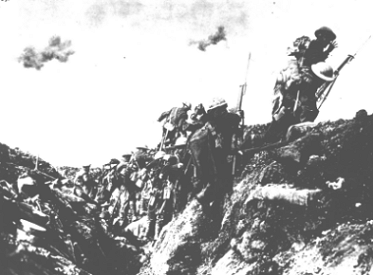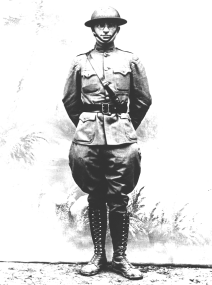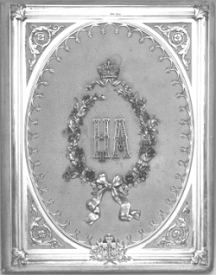
The Record - September 1998
The Great War: World War I and the American Century -
A Ford Museum Exhibit
By James Kratsas
On November 11, 1918 a five-year old Gerald R. Ford joined the rest of Grand Rapids in celebrating the first Armistice Day. As the bells rang and jubilant crowds surged into the streets, few Grand Rapidians looked beyond the cessation of hostilities in what Ford's generation called the Great War. Barely 18 months had passed since a reluctant President Woodrow Wilson led his country into battle against Old World autocracy as personified by Germany's bombastic Kaiser Wilhelm II. Over 100,000 of Wilson's countrymen had lost their lives in "the war to end war." By the time the guns at last fell silent in November 1918 the map of Europe had been radically changed.
- From the Forbes Collection in New York, an extraordinary diamond-and-silver Faberge imperial writing portfolio, presented to Their Imperial Majesties Nicholas and Alexandra by the city of St. Petersburg on the occasion of their 1896 coronation.
- Harry Truman's wartime cape and other artifacts, from the Truman Library.
- From the John F. Kennedy Library in Boston, part of the original manuscript of Ernest Hemingway's A Farewell to Arms.
- Theodore Roosevelt's telegram to Woodrow Wilson requesting permission to raise two divisions to fight in Europe.

"Going Over the Top"
World War I is the cradle of modern civilization. More than any other event, it shaped the 20th century, toppling kings, ushering in the Soviet Union, transforming relations between and within nations. The first truly mechanized war, it was fought with poison gas and bombs dropped from the air, with tanks and machine guns and in trenches stretching for 600 miles. Offsetting the lethal ingenuity of modern mass warfare, the Great War also inspired unforgettable songs, poetry, and literature. Words like liaison, Tommy, anddoughboy enriched the popular vocabulary. On the homefront, Americans saw their government swell to a cost and scope never before imagined. Self-denying patriotism spawned Meatless Mondays and Wheatless Wednesdays, and sugarless gum was invented as a caloric test of Allied solidarity.

Harry Truman in his World War I uniform. (On exhibit courtesy of the Harry S. Truman Library)
To do justice to this epic conflict, Ford Museum staffers have been combing institutional and individual collections throughout the United States. Drawing upon the resources of the Smithsonian Institution, the Library of Congress, the Liberty Memorial in Kansas City, the U.S. Naval Academy, and several presidential libraries, among others, they have secured hundreds of historically significant artifacts. Among the objects coming to Grand Rapids for display are the following:
- Kaiser Wilhelm's naval cape, on loan from the Smithsonian Institution's National Museum of American History in Washington, DC.
- Woodrow Wilson's death mask, loaned by the same institution.

Imperial writing portfolio belonging to Czar Nicholas II and created by Faberge. Leather with gilded silver and diamonds. (On loan from Forbes Collection, New York)
- Wilson's copy of the Treaty of Versailles ending the war.
- A remarkable collection of Prussian officer helmets, along with other headgear worn by soldiers in the Kaiser's army.
- Personal memorabilia of Dwight Eisenhower, Douglas MacArthur, and Sergeant Alvin York.
- Gorgeously embroidered flour sacks, sent by grateful Belgians to the American people in recognition of Herbert Hoover's billion-dollar effort to keep 10 million Europeans from starvation.
An original 75mm French artillery piece greets visitors at the entrance to the exhibit, which will fill over 3,500 square feet adjoining the Ford Museum's permanent galleries. Centerpiece of The Great War will be a recreated trench, complete with sound effects and a machine gun nest, that will enable visitors to vividly experience for themselves life in No Man's Land. Overhead, largescale model planes hanging from the rafters of the museum will recall the early air war. Dozens of period uniforms and weapons will be displayed.
Also receiving prominent attention will be the role played by women in the war, with special emphasis upon the work of the Red Cross.
The Great War is not a traveling show. It can only be seen at the Ford Museum, and only until January 10, 1999.
James Kratsas is Curator, the Gerald R. Ford Museum.